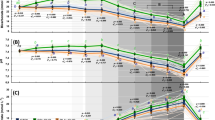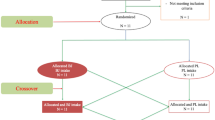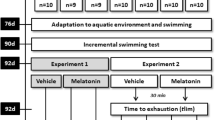Abstract
Objectives:
L-ornithine has an important role in ammonia metabolism via the urea cycle. This study aimed to examine the effect of L-ornithine hydrochloride ingestion on performance during incremental exhaustive ergometer bicycle exercise and ammonia metabolism during and after exercise.
Subjects/Methods:
In all, 14 healthy young adults (age: 22.2±1.0 years, height: 173.5±4.6 cm, body mass: 72.5±12.5 kg) who trained regularly conducted incremental exhaustive ergometer bicycle exercises after -ornithine hydrochloride supplementation (0.1 g/kg, body mass) and placebo conditions with a cross-over design. The exercise time (sec) of the incremental ergometer exercise, exercise intensity at exhaustion (watt), maximal oxygen uptake (ml per kg per min), maximal heart rate (beats per min) and the following serum parameters were measured before ingestion, 1 h after ingestion, just after exhaustion and 15 min after exhaustion: ornithine, ammonia, urea, lactic acid and glutamate. All indices on maximal aerobic capacity showed insignificant differences between both the conditions.
Results:
Plasma ammonia concentrations just after exhaustion and at 15 min after exhaustion were significantly more with ornithine ingestion than with placebo. Plasma glutamate concentrations were significantly higher after exhaustion with ornithine ingestion than with placebo.
Conclusions:
It was suggested that, although the ingestion of L-ornithine hydrochloride before the exercise cannot be expected to improve performance, it does increase the ability to buffer ammonia, both during and after exercise.
This is a preview of subscription content, access via your institution
Access options
Subscribe to this journal
Receive 12 print issues and online access
$259.00 per year
only $21.58 per issue
Buy this article
- Purchase on Springer Link
- Instant access to full article PDF
Prices may be subject to local taxes which are calculated during checkout

Similar content being viewed by others
References
Allen DG, Lamb GD, Westerblad H (2008). Skeletal muscle fatigue: cellular mechanisms. Physiol Rev 88, 287–332.
de Araujo Jr JA, Falavigna G, Rogero MM, Pires IS, Pedrosa RG, Castro IA et al. (2006). Effect of chronic supplementation with branched-chain amino acids on the performance and hepatic and muscle glycogen content in trained rats. Life Sci 79, 1343–1348.
Demura S, Yamada T, Yamaji S, Komatsu M, Morishita K (2010). The effect of L-ornithine hydrochloride ingestion on human growth hormone secretion after strength training. Adv Biosci Biotech 1, 7–11.
Evain-Brion D, Donnadieu M, Roger M, Job JC (1982). Simultaneous study of somatotrophic and corticotrophic pituitary secretions during ornithine infusion test. Clin Endocrinol 17, 119–122.
Graham TE, MacLean DA (1992). Ammonia and amino acid metabolism in human skeletal muscle during exercise. Can J Physiol Pharmacol 70, 132–141.
Hirai T, Minatogawa Y, Hassan AM, Kido R (1995). Metabolic interorgan relations by exercise of fed rats: carbohydrates, ketone body, and nitrogen compounds in splanchnic vessels. Physiol Behav 57, 515–522.
MacLean DA, Spriet LL, Hultman E, Graham TE (1991). Plasma and muscle amino acid and ammonia responses during prolonged exercise in humans. J Appl Physiol 70, 2095–2103.
Meneguello MO, Mendonça JR, Lancha Jr AH, Costa Rosa LF (2003). Effect of arginine, ornithine and citrulline supplementation upon performance and metabolism of trained rats. Cell Biochem Funct 21, 85–91.
Norton LE, Layman DK (2006). Leucine regulates translation initiation of protein synthesis in skeletal muscle after exercise. J Nutr 136, 533S–537S.
Okuda T (1966). Direct colorimetry of blood ammonia. Med Front 21, 622–627.
Rodwell VW (2000). Conversion of amino acids to specialized products. In: Murray RK, Granner DK, Mayes PA, Rodwell PW (eds). Harper's Biochemistry, 25th edn, New York: Appleton and Lange.
Sahlin K, Katz A, Broberg S (1990). Tricarboxylic acid cycle intermediates in human muscle during prolonged exercise. Am J Physiol 259, C834–C841.
Smith WA, Fry AC, Tschume LC, Bloomer RJ (2008). Effect of glycine propionyl-L-carnitine on aerobic and anaerobic exercise performance. Int J Sport Nutr Exerc Metab 18, 19–36.
Stathis CG, Febbraio MA, Carey MF, Snow RJ (1994). Influence of sprint training on human skeletal muscle purine nucleotide metabolism. J Appl Physiol 76, 1802–1809.
Sugino T, Shirai T, Kajimoto Y, Kajimoto O (2008). -ornithine supplementation attenuates physical fatigue in healthy volunteers by modulating lipid and amino acid metabolism. Nutr Res 28, 738–743.
van Loon LJ, Kruijshoop M, Verhagen H, Saris WH, Wagenmakers AJ (2000). Ingestion of protein hydrolysate and amino acid-carbohydrate mixtures increases postexercise plasma insulin responses in men. J Nutr 130, 2508–2513.
Wada M, Matsunaga T (1997). Factors regarding muscle fatigue. In: Katsuta S (ed). Exercise Physiology. Kyorinshoin: Tokyo. pp 77–83.
Wasserman K (1976). Testing regulation of ventilation with exercise. Chest 70, S173–S178.
Zoeller RF, Stout JR, O’kroy JA, Torok DJ, Mielke M (2007). Effects of 28 days of beta-alanine and creatine monohydrate supplementation on aerobic power, ventilatory and lactate thresholds, and time to exhaustion. Amino Acids 33, 505–510.
Author information
Authors and Affiliations
Corresponding author
Ethics declarations
Competing interests
Demura S, Yamada T and Yamaji S received financial support from Kyowa Hakko Bio Co, Ltd. The other authors declare no conflict of interest.
Rights and permissions
About this article
Cite this article
Demura, S., Yamada, T., Yamaji, S. et al. The effect of L-ornithine hydrochloride ingestion on performance during incremental exhaustive ergometer bicycle exercise and ammonia metabolism during and after exercise. Eur J Clin Nutr 64, 1166–1171 (2010). https://doi.org/10.1038/ejcn.2010.149
Received:
Revised:
Accepted:
Published:
Issue Date:
DOI: https://doi.org/10.1038/ejcn.2010.149
Keywords
This article is cited by
-
Combination of tea catechins and ornithine effectively activates the urea cycle: an in vitro and human pilot study
European Journal of Applied Physiology (2024)
-
Human milk extracellular vesicles enhance muscle growth and physical performance of immature mice associating with Akt/mTOR/p70s6k signaling pathway
Journal of Nanobiotechnology (2023)
-
Serum Amino Acid Profile Changes After Repetitive Breath-Hold Dives: A Preliminary Study
Sports Medicine - Open (2022)
-
Randomised controlled trial of the effects of L-ornithine on stress markers and sleep quality in healthy workers
Nutrition Journal (2014)
-
In vitro recapitulation of the urea cycle using murine embryonic stem cell-derived in vitro liver model
Amino Acids (2013)



